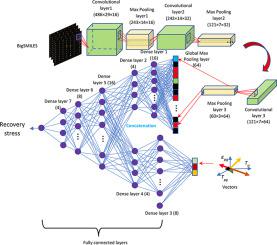Polymer ( IF 4.1 ) Pub Date : 2020-12-30 , DOI: 10.1016/j.polymer.2020.123351 Cheng Yan , Xiaming Feng , Collin Wick , Andrew Peters , Guoqiang Li

|
In the past couple of years, machine learning (ML) has been widely leveraged in discovering functional materials. However, several difficulties seriously impede the application of ML in the field of thermoset shape memory polymers (TSMPs), e.g., the intractable feature identification or fingerprinting, inadequate experimental data on recovery stress, programming stress, strain, and lack of multilength scale structural information. Hence there is currently a lack of studies towards ML-assisted discovery of TSMPs. In this study, we propose a series of methodologies to cope with the difficulties, i.e., adopting the most recently proposed linear notation BigSMILES in fingerprinting, supplementing existing dataset by reasonable approximation, leveraging a mixed dimension (1D and 2D) input model and a type of dual-convolutional-model framework. By doing these, a new ML framework for predicting the recovery stresses of TSMPs is developed, which is validated by synthesizing and testing two new epoxy networks predicted by the ML model. By forging new TSMPs space with 4,459 samples, the ML model identified and screened 14 mostly unknown TSMPs with greater recovery stress than the known TSMPs. One of the 14 predicted polymers was validated by molecular dynamics (MD) simulation. This study demonstrates the capability of our methodologies for discovering new TSMPs with desired recovery stress by a small training dataset and may be adopted for discovering new TSMPs with other desired properties.
中文翻译:

机器学习基于一个小的训练数据集协助发现新的热固性形状记忆聚合物
在过去的几年中,机器学习(ML)在发现功能材料方面已得到广泛利用。但是,一些困难严重阻碍了ML在热固性形状记忆聚合物(TSMP)领域的应用,例如,难以处理的特征识别或指纹识别,有关恢复应力,编程应力,应变的实验数据不足以及缺乏多长度尺度结构信息。因此,目前尚缺乏有关ML辅助发现TSMPs的研究。在这项研究中,我们提出了一系列方法来应对这些困难,例如,在指纹识别中采用最新提出的线性符号BigSMILES,通过合理的近似补充现有数据集,利用混合维度(一维和二维)输入模型和一种类型双卷积模型框架。通过这样做,开发了一种用于预测TSMPs恢复应力的新ML框架,该框架通过合成和测试ML模型预测的两个新的环氧网络得到了验证。通过用4459个样本创建新的TSMP空间,ML模型识别并筛选了14个大多数未知的TSMP,其恢复压力比已知的TSMP大。通过分子动力学(MD)模拟验证了14种预测的聚合物之一。这项研究证明了我们的方法论通过一个小的训练数据集发现具有所需恢复压力的新TSMP的能力,并且可能被用于发现具有其他所需属性的新TSMP的方法。通过用4459个样本创建新的TSMP空间,ML模型识别并筛选了14个大多数未知的TSMP,其恢复压力比已知的TSMP大。通过分子动力学(MD)模拟验证了14种预测的聚合物之一。这项研究证明了我们的方法论通过一个小的训练数据集发现具有所需恢复压力的新TSMP的能力,并且可能被用于发现具有其他所需属性的新TSMP的方法。通过用4459个样本创建新的TSMP空间,ML模型识别并筛选了14个大多数未知的TSMP,其恢复压力比已知的TSMP大。通过分子动力学(MD)模拟验证了14种预测的聚合物之一。这项研究证明了我们的方法论通过一个小的训练数据集发现具有所需恢复压力的新TSMP的能力,并且可能被用于发现具有其他所需属性的新TSMP的方法。










































 京公网安备 11010802027423号
京公网安备 11010802027423号